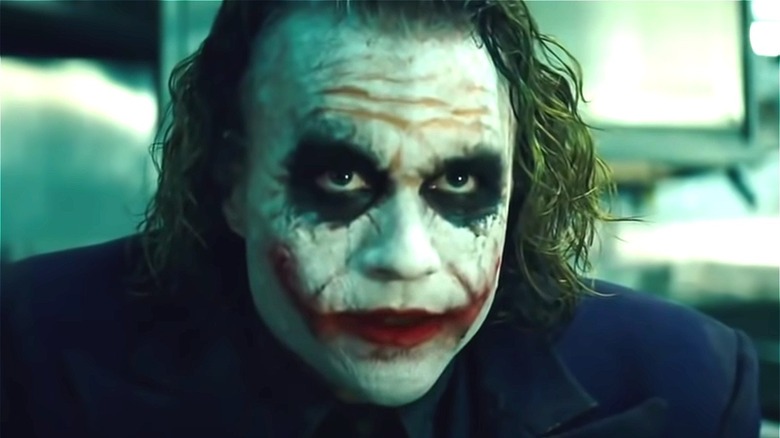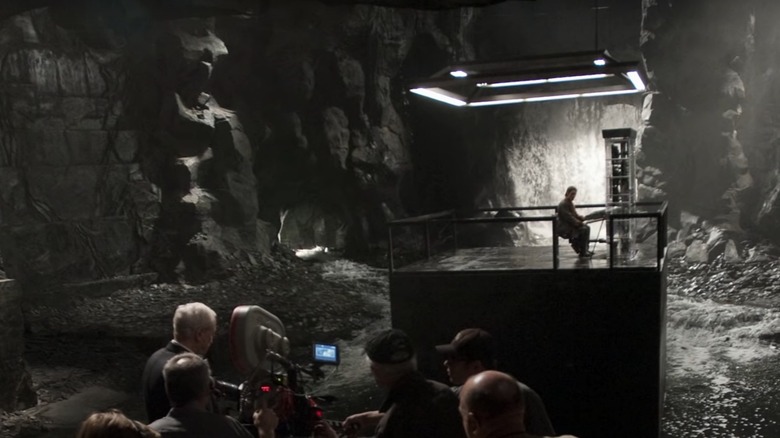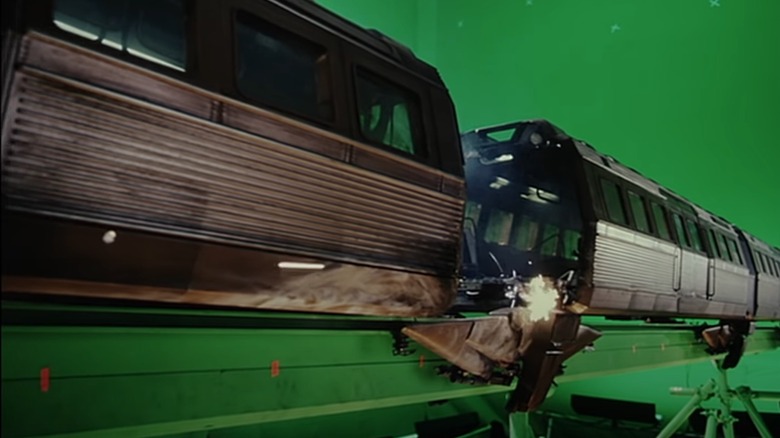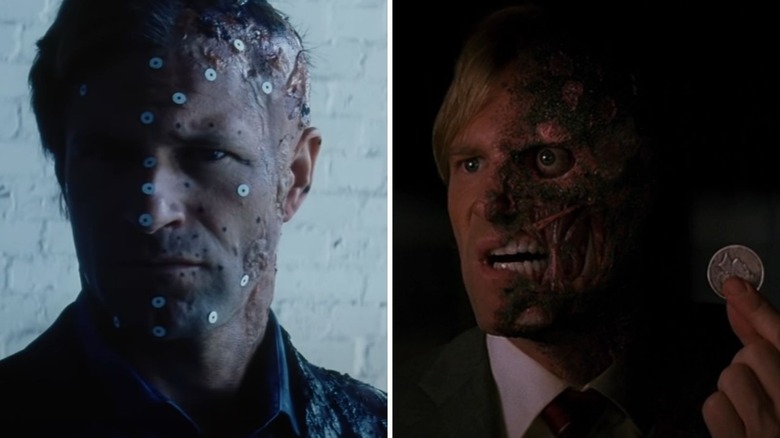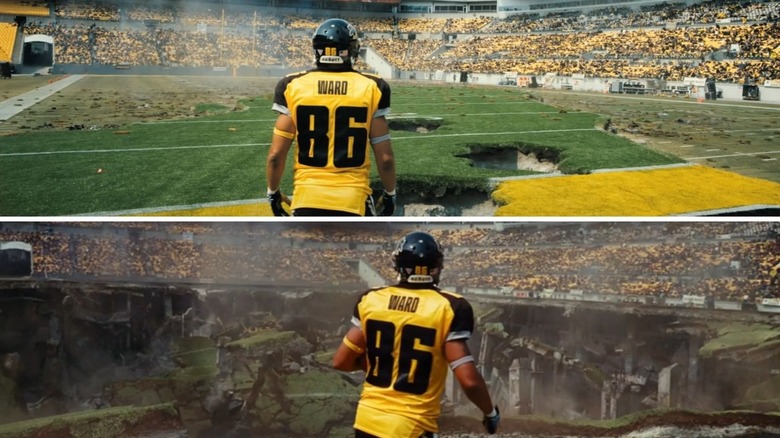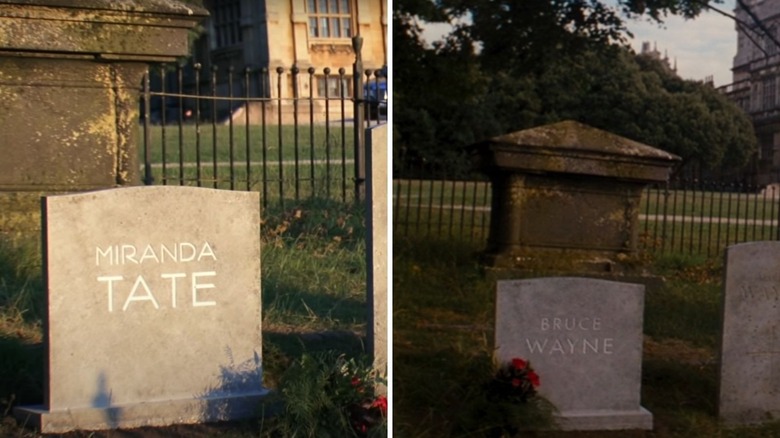What The Dark Knight Movies Looked Like Before Special Effects
Hot off the high of "The Batman," it's time to go back to the classics: "The Dark Knight" trilogy. In a fresh take on the hero, Christopher Nolan took the creature of the night and made a dark, gritty Gotham worthy of his broodiness when he directed "Batman Begins." Following suit, Christian Bale put on an armored Batsuit and growled his way through everything his villains threw at him. Then "The Dark Knight" came along and Heath Ledger gave us all a Joker we'll never forget when he asked, "Why so serious?"
Throughout the trilogy, Nolan kept his Gotham grounded in a reality that feels just a hair away from ours — the movies have just enough spectacle to impress, but don't go so far as to become truly unbelievable. It's a tone carefully matched to the hero who doesn't have superpowers. Still, there's clearly some movie magic going on here, so what's real and what's not?
They actually built the whole Batcave
Whenever possible, director Christopher Nolan uses practical effects as opposed to computer-generated images. For "Batman Begins," the crew built a sprawling life-size set of Gotham in a massive airplane hanger, with streets, buildings, and even a section of highway hooked up with street lights and steam underneath. On another stage, they built the entirety of the Batcave and flooded it to give it an underground river. To get overhead shots of Gotham, they filmed in Chicago, then digitally added in the monorail and Wayne Tower (via YouTube).
"I certainly never try to put any kind of visual effects restriction on the films," Nolan said in a behind-the-scenes interview. "But my absolutist view of the way computer graphics works is that it's animation." He said if the scene doesn't have a basis in live-action or miniatures, the audience will subconsciously know they're watching "animation as opposed to photography." Of course, the practical effects weren't always practical: They tried to use real bats for the swarms throughout the movie, but the bats quickly persuaded them to opt for CGI instead.
Nolan prefers to augments his practical effects with digital
Many of the show-stopping set pieces in "The Dark Knight" trilogy were actually done for real. One of the most ambitious was the truck flip in "The Dark Knight" — the special effects team flipped an entire 18-wheeler truck in the middle of a Chicago street, per IGN. However, some things just need to be digital.
The three movies are made with a complex mix of sets built to scale, on-location shots, miniatures, and CGI elements combined together. "Sometimes you do end up replacing a filmed shot with visual effects," Nolan told Wired in 2008. "[I]f we had started out with that, it wouldn't have looked the same. Because we photographed something, we have a benchmark standard to hold to, even if we change things. Even the film's CG shots are rooted in some kind of photographic reality."
Nolan likes to alternate between practical effects shots and ones heavy with visual effects — ensuring that there aren't several digital shots in a row, but also making sure to end an action sequence on a practical effect (via YouTube). For Batman and Ra's al Ghul's final fight on the monorail in "Batman Begins," the inside shots were filmed in the set pictured above, with the view through the windows added in later. Nolan and the crew then shot the monorail's crash with miniatures, one-sixth the size of real-life and made to look realistic.
The Two-Face special is (almost) all CGI
Probably the most obvious instance of visual effects in "The Dark Knight" is the frightening half of Harvey Dent's (Aaron Eckhart's) face, revealed after he's irreversibly scarred from the Joker's deadly game. Before, he was the shining hero of Gotham, a district attorney committed to ridding the city of its crime, but now he's Two-Face, a villain obsessed with revenge and willing to kill innocent little kids. Half of his face is burned, with a whole eyeball and several jaw muscles exposed, making for a zombie-like effect that goes just past reality.
"We knew we were gonna have to do the effect digitally," director Christopher Nolan said in a behind-the-scenes interview. "I wanted it to be a little bit unreal because we wanted it to be shocking but not depressing ... I felt that with CG, there was a little more window for the audience to accept it, in a slightly more comfortable way." They did, however, use a prosthetic burned scalp, so that Eckhart could see and feel the difference in his character while acting.
The football field only exploded a little
The cast and crew of "The Dark Knight Rises" went to Pittsburgh for much of their filming, turning the Pennsylvania summer into Gotham's winter. This movie called for extreme destruction to Gotham, though, so the explosions Bane (Tom Hardy) sets off throughout the city are largely CGI. However, the crew got boots on the ground to film the disaster happening at a very crowded football game. While players are running on the field, it begins collapsing inwards, crumbling away to create a giant pit. To create the shot, the special effects team did not destroy the Steelers' field, but they did use a combination of practical effects and CGI. "I challenged everybody to put as many real elements in that frame as possible," director Christopher Nolan said in a behind-the-scenes interview.
The crew blew bursts of dirt into the air and got 10,000 extras to populate the stands. To really enhance the scene, they built a raised platform on top of the football field that looked just like the field, but had several holes in its surface. The football player stuntmen ran across it and fell into the holes, so they could disappear out of the shot. With the stuntmen on camera, the visual effects team then changed the field beneath their feet to be the opening maw of earth we see in the movie (via YouTube).
A small digital change kept a big secret
The team working on "The Dark Knight Rises" even used visual effects, not because of filming difficulties, but to keep the ending of the movie a secret. Batman doesn't simply save the day and go right back to his vigilantism: To save Gotham, he flies a bomb out of the city and over the ocean in what appears to be a self-sacrificial mission. In the aftermath, his close friends and allies hold a funeral for Bruce Wayne, outside of Wayne Manor, where his parents were buried. There, next to their headstones, is a fresh one reading: Bruce Wayne.
However, when they filmed the scene, the gravestone was inscribed with the name Miranda Tate — aka Ra's al Ghul's daughter and an antagonist of the movie. The visual effects team edited the shot afterward to read the correct name, to ensure Batman's death was kept secret before the movie's release. Of course, in the last shots of the film, it's revealed that Bruce Wayne is actually alive: He fixed the autopilot on his aircraft and faked Batman's death to live free of the cape with Selina Kyle.
On top of the fake gravestone, director Christopher Nolan had Christian Bale come to the set that day, just so his name would be on the call sheet if it was leaked. In a behind-the-scenes interview, Nolan explained that this was the furthest they'd ever gone to keep an element of the trilogy secret.
